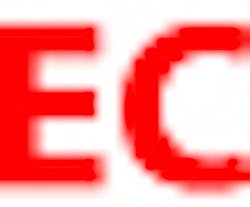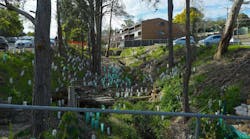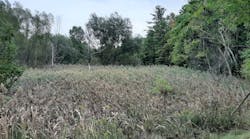Hydroseeding’s roots lie in agriculture and forestry, where its ability to broadcast seeds over large, inaccessible areas quickly, safely, accurately, and with a relatively high probability of germination offers distinctive advantages. Applying seed in a liquid medium has a number of benefits: The added mass increases accuracy and throw distance; adds stability in exposed, windy areas; accelerates germination; and enhances the survival rate of resulting plants. Seed mixtures, binders, matrix, machinery, and dispersal equipment have been the subject of continuous improvement, allowing hydroseeding’s success rate to rival or even exceed that of traditional planting methods.
Hydraulic applicators have developed specialized techniques in response to their application equipment, materials, site-specific conditions, and the purpose behind a particular action. If the concern is dust control during grading activities—a short-term application—the approach is different than holding soil or tailings in place over an extended period of time until plant growth takes over. Slope, soil types and conditions, climate and weather, anticipated use, and what risks lie downstream are complicating factors. At the extremes – planting a lawn or armor plating a burned-out hillside – the choices are reasonably clear-cut. The projects that fall in the middle of the spectrum are those that require knowledge and experience.
While hydraulic mulching machines are capable of dispensing virtually any mixture with consistencies ranging from water to mud, economics has honed applications to the dispersal of seeds, sprigs, stolons, soil amendments, mulch, tackifiers, gels, binders, and limaceous and bonded fiber matrix (BFM) materials.
Fertilizers, Mulches, Additives
The ability to combine seed and fertilizer prior to application—a step guaranteeing favorable distribution of materials and permitting custom blending at the tank—reduces reliance on complete—composition fertilizers and allows use of lower-cost, off-the-shelf fertilizers and bulk additives.
The most common hydromulches, made of paper, wood fiber, or a combination of the two, act as a carrying agent in the hydroseeding process. When used with conventional guar-based tackifiers, they prevent washing and rippling while holding nutrients in close contact with the seed. Additives (moisture-retention agents and tackifiers), fertilizers, and seed are all applied in one treatment.
All states have specifications for both paper and wood-fiber – based mulches, which enjoy wide use in a variety of tasks. Cost and site-specific performance requirements are the principal factors in their selection. Wood-fiber mulches are manufactured by a defibrating process in which wood chips are softened by steam and pulled apart under pressure. The fibers are shredded from the wood chip, then dyed, dried, and packaged. Fiber length is one of the main factors in comparing these mulches. For a fine lawn application, for example, a mixture of shorter and longer fibers provides close contact of seed and nutrients while effectively straddling the smaller soil particles of fine-raked areas. For erosion control applications, longer fiber lengths might be more desirable since soil particle sizes are typically larger. The holding capacity of tackifiers is generally improved when used in conjunction with the longer fiber mulches.
Paper hydraulic mulches are generally made from newspaper, cardboard, or other waste paper. While paper mulches have loading rates up to 60% higher than wood-fiber mulches, the mulch rate required to provide equal coverage is generally higher as well (it takes between 20% and 40% more paper mulch to achieve the same visual coverage of wood mulch). In general it is not advisable to use paper mulches with liquid soil-bonding agents, as the resulting papier-mâché could block air and moisture from reaching the germinating seed.
Liquid or powder additives are incorporated as needed, giving hydroseeding an advantage over conventional seeding techniques. Powdered tackifiers, most frequently made of vegetable bases such as guar gum or Plantagro, are relatively inexpensive and provide good holding power on moderate slope conditions. Relatively short-lived, they should be restricted to situations in which favorable growing conditions ensure that plants will become established before the holding power decreases. When used in turf establishment to prevent washing and rippling, their effectiveness rarely exceeds two to three months and can be adversely affected by conditions of excessive surface runoff.
Liquid soil-bonding agents can maintain their effectiveness for up to two years, biodegrading over time or more rapidly in response to plant growth. While they may provide erosion protection whether or not vegetation is established, these products generally allow water to flow over the top of the mulched area and are subject to both temperature and moisture limitations during application.
Moisture retention agents (MRAs), usually powdered products capable of retaining up to 200 times their weight in water, reduce water requirements in both turf establishment and erosion control applications. While MRAs are available in synthetic or organic starch-based form, the latter works better with hydroseeding applications while the former works well as a soil amendment. Starch-based products typically last about 30 days, capturing and retaining available moisture over an extended period. While MRAs may reduce artificial watering requirements, they are of no value on a site where there is no available moisture to retain.
While various hydroseeding practices seem to have much in common—often because the same equipment is used—project objectives, types and consistencies of materials specified for use, physical environment (soils, gradient, weather), and performance characteristics of the equipment introduce significant differences.
Unlike bare-bones erosion control, turf establishment carries with it the burden of irrigation and possibly periodic nutrient amendment as well. Soil preparation and seed selection are the same as for hydroseeding as any other form of turf establishment. Erosion control specifications should take into consideration existing site conditions and available nutrients. Moisture, seed selection, and quantities used should reflect these limitations. There are distinct differences in the way specifications are written for each application.
Where the resulting vegetation will not be maintained, it is better to provide seeds that germinate in a wide variety of pH and other soil conditions than to artificially adjust soil conditions on a temporary basis. Specifying large quantities of seed does not necessarily lead to better erosion protection, as increased competition could result. Seed quantities should not exceed the amount sufficient to provide the minimum number of plants to retain the soil. Fertilizer is used to provide nutrients only during the establishment period, since most of these applications are not maintained or refertilized.
Regardless of specific soil type, flat areas are the least expensive to revegetate. A minimum application of mulch with adequate seed and fertilizer should provide sufficient cover for temporary or permanent erosion control. Generally a site should be left in back-bladed condition with soil loosened by disking. If additives are used, extra mulch material may be required to bind them to the seed and soil.
While slope and soil type (sand, clay, and so on) are the most obvious site considerations for erosion control, they might not be the most important. Subsurface drainage on cut or fill slopes and seasonal effects of sun angle are often overlooked, and there is a tendency to try to confront these variables with surface protection measures. Subsurface drainage occurring between soil layers can cause saturation of the soil and eventually cause slope failure. To counter this condition, dark violet dyes can be used to absorb more heat, helping speed germination. A soil-bonding agent can be used to retain the soil to allow for a slower germination rate in winter applications. In summer when western slopes dry faster and show less growth than the shaded east slopes, counteracting the effects of sun angle may be of higher concern than adhering material to the slope.
Selection of Hydraulic Application Equipment
While vehicle selection is up to the user, operational considerations such as gross vehicle weight, tire loading, tread, overhang, maneuverability, terrain clearance, field maintainability, and power train capacity figure into the equation. Selection of the hydraulic application equipment itself is based on separate criteria that take into account the type and scale of operations, materials to be dispensed, methods and techniques of application, ruggedness and serviceability of the components, and the operator’s comfort with the equipment.
Sizes range from pickup truck—mounted, 300-gal. pumpers for smaller, specialized (primarily turf seeding) applications to 10-wheeled, 4,000-gal. behemoths capable of tackling a wide variety of large construction and public works projects.
|
Table 1: Acres per Hour for Different Fiber Mulch Application Rates
|
|||
| 1,200 lb/ac. | 1,600 lb./ac. | 2,000 lb./ac. | |
| 1,000 gal. | 0.44 | 0.33 | 0.26 |
| 3,000 gal. | 1.00 | 0.77 | 0.62 |
Table 1 shows the relationship between fiber-mulch capacity of the machine and a specified application rate. Cycle time—the time required to drive to the spray area, discharge the tank, and return to the fill point—is a critical element in the cost equation. For this analysis, one hour is used as the cycle time for a 3,000-gal. unit and 45 minutes for a 1,000-gal. machine.
There are coverages for different specifications and tank sizes. The principal equipment manufacturers are Bowie Industries of Bowie, TX; Finn Corporation of Fairfield, OH; and Reinco Equipment of Plainfield, NJ. Within a given line, the differences are more a matter of scale than basic design. A 1,500-gal. Reinco has a larger pump and power plant than its 1,000-gal. brother, but both use similar agitation and application systems and most of the hardware is interchangeable. Finn and Bowie employ different strategies in their mixing and agitation systems, but within their own lines there is little distinction outside of size and capacity. Centrifugal pumps are in general use because of their superiority in top-gun applications, but all manufacturers offer gear or advancing cavity positive-displacement pumps for long-distance hose and/or heavy-slurry activities.
Cost and Productivity Analysis
Hydroseeding is not so much a science as it is a time-proven method that literally can be followed by cookbook recipes. The basis of the application is normally determined by specifications that are provided by landscape architects, the Natural Resources Conservation Service, or an academic institution. In almost all cases, specifications are subject to local conditions.
Several basic assumptions are made that allow costs to be broken down to an hourly basis and through a transition of productivity equivalents to a unit cost per coverage area. Labor, materials, and equipment amortization are taken into account. Grading and ground prep, however, are not included.
While costs of equipment, materials, and labor will vary, the following analysis provides ballpark figures with which to compare hydroseeding to other turf-seeding or erosion control practices. It also converts fixed operational costs to an hourly cost. In aggregate, they show that, considering projected use at 250 hours per year, anticipated unit costs are somewhere between $0.0175 and $0.0225/ft.2, yielding a return on investment of between 87% and 106%.
This entire analysis is based on a conservative usage of 250 hours per year. The combined hourly lease cost is calculated by multiplying the monthly lease payment by 12, then dividing this amount by 250 hours. For example:
1,000-gal. seeder = $455 x 12 = $5,460
$5,460 ÷ 250 hours = $21.84 per hour
Table 2 is a sample cost summary for two specifications assuming 240-hours-per-year utilization of equipment.
| Table 2. Cost Summary for Material Labor and Equipment ($/ac.) | ||
| ITEM | 1,000 gal. | 3,000 gal. |
| Spec 1 | ||
| Equipment | 120 | 100 |
| Material | 650 | 650 |
| Labor | 150 | 75 |
| Total | 920 | 825 |
| Spec 2 | ||
| Equipment | 165 | 135 |
| Material | 675 | 675 |
| Labor | 200 | 100 |
| Total | 1,040 | 910 |
| Spec 1: 500 lb. fertilizer, 200 lb. seed, and 1,200. lb fiber mulch.Spec 2: 500 lb. fertilizer, 200 lb. seed, and 1,600 lb. fiber mulch. | ||
Labor cost assumes three workers at $20/hr. including taxes, insurance, and benefits. Again, this is conservative, as operations generally require a crew of only two.
Productivity is influenced by the equipment’s fiber capacity. Under most circumstances the maximum quantity of fiber mulch that can be loaded into a full tank establishes the limit for ground coverage for each tankload. This limit averages about 400 lb. of fiber mulch per 1,000 gal. of water, though under some circumstances higher proportions are possible. An acre normally requires between an absolute minimum of 800 lb. to as much as 2,500 lb. of fiber mulch. And typically, at least 3,000 gal. of water is required to mix and spray 1,500 lb. of fiber mulch.
Where specs have been followed, hydroseeding is recognized as a viable and valuable erosion control option. Where deviation—whether for fraudulent “creative” purposes—has been tolerated (encouraging corner-cutting by applicators and contractors alike), the industry has encountered erosion of its own in the confidence of engineers and architects who cannot be sure of results. The answer lies partly in adherence to specifications by contractors and applicators but also in their ability to pass along to specifiers an appreciation for the actual costs involved so they will recognize and ignore unrealistic bids that guarantee substandard performance.


